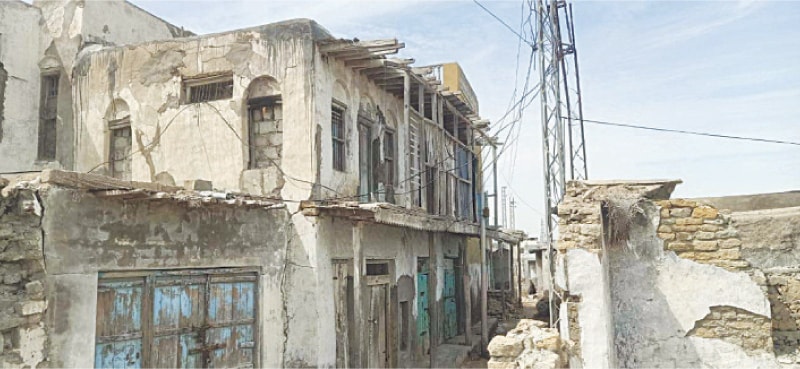Ruins of Gwadar’s Shahi Bazaar
The streets of GWADAR’s Shahi Bazaar are home to stories. That date back centuries, making it as regal as its name suggests.
The port town’s historic market is recognized as a heritage site. In addition to being a thriving center for trade. The buildings from before the partition have withstood the test of time. But today they must contend with the effects of climate change.
The already-deteriorating structures of the bazaar have suffered greatly. From the recent intense rains. The rain hasn’t stopped for more than a month, yet the market’s water hasn’t been removed yet.
Drainage wasn’t a problem for the market until a few years ago because the water would run down to the sea. Nevertheless, the Gwadar East Bay Expressway’s development interrupted the natural stream.
February’s torrential rains severely damaged Shahi Bazaar’s old structures.
The main port town is connected to the Makran Coastal Highway. By this recently completed road, which was constructed at a cost of $168 million. Under the China-Pakistan Economic Corridor (CPEC). Rainwater currently collects in and around Shahi Bazaar after the building.
A Magnificient History of Gawadar’s Shahi Bazaar
People who have been in the market for many years reminisce about the good old days. When the bazaar was busy with people and lit by oil lamps all night long.
The market was established during the Omani Sultanate’s authority in Gwadar. According to the locals, which explains. Why the buildings still have remnants of Omani architecture. Relics of Portuguese architecture can also be found in a few other structures in the market.
Before the Partition, Gwadar was ruled by the Khan of Kalat. After he fell out with the monarch and sought safety in the neighboring state. The brother of Oman’s then-ruler, Sultan Bin Ahmed, was given suzerainty over the port.
Ahmed declined to give Gwadar back to the state of Kalat after taking power in Oman. Gwadar Port was “purchased” for $3 million in 1958. But it wasn’t until after four years of rigorous talks. And much struggle on the side of the people that the port was finally included into Pakistan.
“Traders would come to the Shahi Bazaar for trade from across the Makran region,” . Remembers radio mechanic Eid Mohammad Baloch, also known as Eido. Who owned a store in the bazaar for the previous 50 years.
In addition, there is an Ismaili school, a temple, and a Jamaat Khana in the market. The Ismaili community constructed the school. As the first educational institution in the area.
Some of the earliest residents of Gwadar were Ismailis, who were involved in trading. Despite a significant decline in population, their Jamaat Khana. Which was originally founded in the Ismaili Mohalla in 1850, remains intact.
One of the three Jamaat Khanas founded worldwide in 1850 was the prayer center in Gwadar. According to Ali Mansoor, an Ismaili Muslim community member.
“The other two were built using the same plans as the Jamaat Khana in Gwadar, in Africa and India.”
The majority of the structures along Gwadar’s Shahi Bazaar small strip are made of concrete, wood, or mud. Even though the majority of these homes are now in poor condition. Their little wooden balconies remain as the only remaining pieces of historical architecture.
The tea store Kareemoka Hotel is one of the most popular destinations in Shahi Bazaar. There are generally a lot of people there having tea and talking about local issues. The store owned by Khuda Bakhsh Halwai. And the radio mechanic Eido are two other well-liked locations.
Ruins of cultural heritage
These stores had already become run-down as a result of carelessness and neglect. They are now in a condition of decay due to the heavy rainfall.
Eido mentioned in his talk with the media. That Gwadar has previously experienced floods. Intense rain, and other natural disasters.
“The Shahi Bazaar was impacted by floods back in 2010 as well,.” he remarked, emphasizing that the destruction brought on. By the recent rains was even more severe.
When one walks through Gwadar Shahi Bazaar winding lanes after a downpour. The damage is evident.
The Omani guard tower has sustained some damage, and the mud homes are in ruins.
Due to its sturdy design. The Jamaat Khana is the sole structure spared from severe destruction.
Nasir Rahim Sohrabi, a Gwadar-based social activist, stated that. “the old heritage buildings are particularly affected by the torrential rains and floods.”
“We have been advocating for the Gwadar’s Shahi Bazaar preservation in all forums. Especially with regard to public heritage.” However, Mr. Sohrabi continued, “there hasn’t been any significant action as of yet.
The entire port town was flooded after the disaster. Drawing harsh condemnation towards the Gwadar Development Authority (GDA). It has been blamed for failing to maintain the Shahi Bazaar’s drainage infrastructure.
GDA representatives, however, have dismissed the criticism. Asserting that they have been working throughout the port town. Including the Shahi Bazaar—to safeguard the structures erected during Omani administration.
GDA Chief Engineer Syed Mohammad Baloch stated. “We have been working to protect the telegraph office and restore the Omani Watch Tower.”
He acknowledged that the market had been harmed. By the recent intense rains, but GDA is still working on restoration projects. To save the historic district and boost travel.
Although Mr. Sohrabi has low expectations for any action taken by the government. He remains steadfast in advocating for Shahi Bazaar’s growth and revitalization.
Regretfully, his demands and cries are fading away. Like the structures of the former Shahi Bazaar.


Comments are closed, but trackbacks and pingbacks are open.